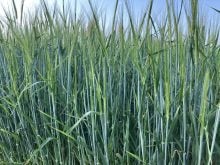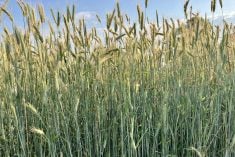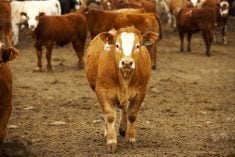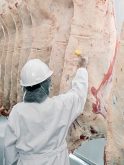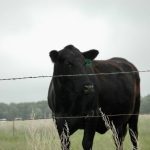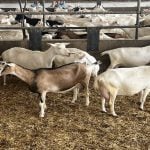As the cattle herd shrinks, leverage has shifted from the retailer through the supply chain to the cow-calf sector. Heavier Canadian steer carcass weights supported fed production in 2024, offsetting smaller slaughter volumes. Fed and feeder cattle prices moved to record highs in the first quarter of 2025, building on momentum from the fourth quarter of 2024. However, tariffs have kept uncertainty running high. A strong lean trim market is supporting cull cow prices. Feed grain prices moved above their 10-year averages recently, pushing the cost of gain higher. Canadian beef export volumes softened slightly in 2024 but remain historically high. Beef imports spiked in 2024, driven by Australia and New Zealand. Tariff threats remain a concern to the entire beef supply chain, stressing the importance of risk management plans.
Tariffs and trade
President Trump made tariffs a staple of his presidential run and has since threatened, delayed, imposed and lifted tariffs on Canadian products entering the U.S. This has destabilized markets on both sides of the border. With the imposition of tariffs over three days during the first week of March, Alberta fed cattle prices declined three per cent from the last week of February, feeder cattle were down four per cent and slaughter cows were down five to six per cent. In Ontario, feeder cattle were down two per cent and cull cows were down eight to 10 per cent. After being removed, most prices rebounded to varying degrees. Uncertainty will remain high until all tariff threats are addressed and removed.
Read Also
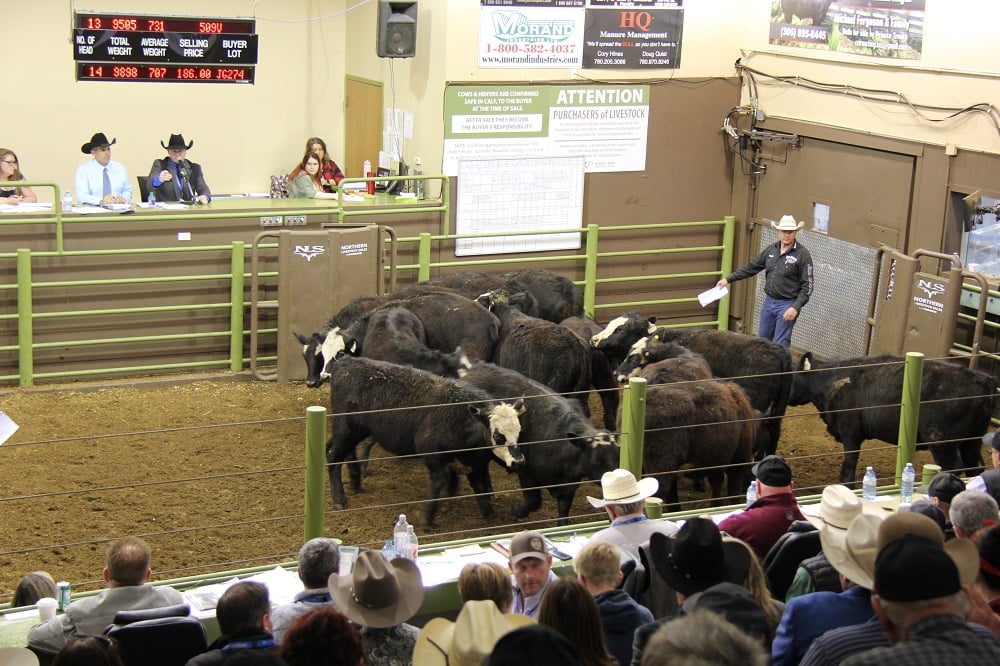
Cattle Market Summary
Break-evens, cow and calf prices, plus market summaries courtesy of Canfax and Beef Farmers of Ontario. Cost of Production October…
Supply indicators
External factors to Canadian herd liquidation
Total Canadian cattle and calves on January 1, 2025, were 0.7 per cent smaller at 10.9 million head and are the smallest since 1988. Inventories were down 0.8 per cent in the West and down 0.4 per cent in the East. Despite a strong price signal to stabilize or expand the herd, continued weather concerns, especially in the West, along with farm succession and competition for land are delaying expansion.

Canadian beef cow inventories were 3.38 million head, down 1.2 per cent (-40,800 head) from last year and are the smallest since 1989. Every province saw a decline in inventories except Ontario (+1.1 per cent) and Quebec (up one per cent). The largest declines were seen in B.C. (-2.4 per cent), the Atlantic provinces (-1.8 per cent), Alberta (-1.6 per cent), Manitoba (-1.5 per cent) and Saskatchewan (-0.9 per cent).
Beef heifers retained for breeding were 520,700 head, up 0.8 per cent (+4,100 head) but that slight rise was insufficient to stabilize beef cow numbers. The largest increase were in Ontario (+6.5 per cent), Atlantic Canada (+5.7 per cent), and Manitoba (+3.8 per cent). Smaller increases were seen in Alberta (+1.8 per cent) and Quebec (+1.4 per cent). Only Saskatchewan (down two per cent) and B.C. (-4.4 per cent) saw a decline in beef heifers retained for breeding.

Calves under 500 pounds and beef heifers for slaughter were down less than one per cent while steers saw a larger decline of almost two per cent. Steers were down in both the West and the East. Beef heifers for slaughter were smaller in the West and larger in the East, with calves relatively stable in both regions.
Canada was a net importer of feeder cattle to the tune of 253,000 head in 2024, surpassing the previous high set in 2021. This will support 2025 beef production. Feeder imports increased by 94,000 head in 2024, fully offsetting the reduction in the 2024 calf crop.
Drought, Mexican screwworm affect U.S. inventories
U.S. cattle inventories on January 1, 2025, at 86.7 million head, were down 0.6 per cent from last year even as cow-calf returns supported expansion. Varying degrees of regional drought continue to be a factor in producers’ decisions.
At 27.9 million head of beef cows, the U.S. herd was down 0.5 per cent from last year. Omitting 2015-19 when the beef cow herd was expanding, this was the smallest year-over-year decline since 2007. The three states that housed the most beef cows (Texas, Oklahoma and Missouri) all saw an increase in their beef cow inventories compared to 2024.

Steers over 500 pounds (-1.0 per cent) and other heifers (-0.6 per cent) declined from last year, partly affected by Mexico detecting New World screwworm in November 2024. Feeder imports from Mexico were suspended until early February 2025. Since then, new protocols have slowed imports. Calves under 500 pounds were also smaller than last year (-0.2 per cent) pointing to continued tightening supplies in the second half of 2025.
Fed beef production increases, non-fed dips
Total beef production (including live slaughter exports) in 2024 was up one per cent from 2023. Fed production was up three per cent while non-fed production was down 12 per cent. Production was supported by record heavy steer carcass weights, 21 pounds heavier than 2023 and 27 pounds heavier than the five-year average.
Total marketings in 2024 were down two per cent from 2023. Fed marketings were up one per cent but were more than offset by a 16 per cent reduction in non-fed marketings. Domestic slaughter was down five per cent with a decline seen in both fed (down two per cent) and non-fed (-18 per cent). Live exports were up 16 per cent, bolstered by fed cattle, which were up 29 per cent to be the largest since 2010. Non-fed exports were down 10 per cent. A weak Alberta-to-Nebraska and Ontario-to-Nebraska cash basis in the fourth quarter of 2024 encouraged fed cattle to move south.
Canadian federally inspected slaughter utilization was 91 per cent in 2024, slightly lower than in 2023 but above the 10-year average. Slaughter utilization was 92 per cent in the West and 85 per cent in the East. Both regions had three weeks where capacity was over 95 per cent of utilization in the fourth quarter.

Over the first 12 weeks of 2025, Canadian steer carcass weights straddled the 950-lb. mark, 26 pounds lighter than the same period in 2024 and 15 pounds heavier than the five-year average. Carcass weights moved counter-seasonally heavier during the first two weeks of March. Year-to-date, domestic beef production is 10 per cent less than last year, with slaughter volumes down nine per cent.
Demand indicators
The Canadian Retail Beef Demand Index (2000=100) at 123, was up slightly from 2023 to 2024 and was the third highest on record going back to 1990. Deflated beef prices in 2024 were three per cent higher than in 2023, while pork prices declined two per cent and chicken prices were down eight per cent. The international beef demand index was 143 in 2024, easing three points from 2023, but was the second highest on record going back to 1990. Beef demand remains strong despite high prices.
Retail beef prices higher
Average retail beef prices in 2024 were $22.26/kg, six per cent higher than in 2023. The largest year-over-year increase was noted on ground beef, which increased 12 per cent from 2023. Retail pork prices were $9.61/kg, steady with 2023, while chicken prices declined six per cent. Retail beef prices in January 2025 were two per cent higher than last year.
The beef-to-pork ratio was 2.32:1 in 2024 with the beef-to-chicken ratio at 2.39:1. Both are the widest on record as beef becomes more expensive at the meat counter. In December, price ratios narrowed near their 2021-2023 averages. But this was short-lived, as they once again moved wider in January 2025.
Beef export volumes dip, imports spike
Canadian beef exports in 2024 were down one per cent from 2023 at 495,000 tonnes. Volumes have been steady at around 500,000 tonnes since 2021. Exports were steady to the U.S., increased six per cent to South Korea and nine per cent to Southeast Asia including Taiwan, but declined 11 per cent to Mexico and five per cent to Japan. The U.S. remained the top destination for Canadian beef in 2024 with 76 per cent market share (by volume), followed by Japan at nine per cent, Mexico at six per cent, with South Korea and Southeast Asia including Taiwan each with three per cent. Export values were down two per cent but were the second largest on record. Exchange rates played a role in trade flows. The U.S. dollar strengthened against the Canadian dollar, making Canadian beef attractive. Meanwhile, the Mexican peso declined against the Canadian dollar between May and September, influencing exports to that market. The Canadian dollar was stable against the Taiwanese dollar, the South Korean won and the Japanese yen, allowing market dynamics to play out.

Beef imports in 2024 were up 12 per cent to be the largest since 2013 with the value up 19 per cent. Non-USMCA imports were up 36 per cent compared to 2023 to over 100,000 tonnes and were 27,000 tonnes above quota. This suggests that some exporters found the Canadian market attractive even with tariffs applied. The U.S. is the largest source of imports with 45 per cent market share, followed by Australia at 14 per cent, New Zealand at 13 per cent, the EU and U.K. at 10 per cent and Uruguay and Mexico at six per cent each.
Cattle prices at new highs in 2025
Markets susceptible to tariffs
Fed steers in Alberta and Ontario found tailwinds to begin 2025 as market fundamentals supported higher prices. Alberta fed steers averaged $271/cwt in January and February, 23 per cent stronger than last year. Tariffs that were imposed during the first week of March on all Canadian exports to the U.S. (including live cattle) put a damper on the fed market in both regions. In March, Alberta fed steers softened one per cent from February but remained 16 per cent stronger than March 2024.

Ontario fed steers averaged $278/cwt in January and February, 20 per cent stronger than last year. A more notable effect was seen on the Ontario fed market in March, with fed steers easing seven per cent from February, but were 11 per cent higher than last year.
Cow prices
After putting in a second-half low in November 2024, Alberta D2 cows rallied higher through the first quarter of 2025. By March, D2 cows averaged nearly $200/cwt, 23 per cent stronger than last year. Ontario D2 cows put in their second-half low in December, then moved mostly sideways through the first quarter of 2025, just shy of $170/cwt. Expectations are that tariffs will result in a 15 per cent drop from baseline (what prices would have been without tariffs). This means that with the cattle cycle, prices will initially drop and then rise. If prolonged, we would get to a point where prices are again higher year-over-year. But they are still 15 per cent below where they should have been.
Monthly Canadian cow slaughter volumes have been below year-ago levels since February 2024, supporting cull cow prices.

Barley and corn above 10-year average
Canadian grain prices moved above the 10-year average in the fourth quarter of 2025, coming off the harvest lows last fall, and increasing cost of gain. However, prices remain below their respective five-year averages. First quarter of 2025 Lethbridge barley averaged $307/tonne, three per cent higher than the first quarter of 2024 and nine per cent above the 10-year average. Ontario corn averaged $245/tonne in the first quarter of 2025, up 17 per cent from last year and up seven per cent from the 10-year average.
The March Outlook for Principal Field Crops released by Statistics Canada estimates barley production for the 2025-26 crop year to be down one per cent from the 2024-25 crop year to eight million tonnes. Exports and imports are both projected to be steady with last year, with total domestic use down two per cent. Ending stocks are projected to be down 24 per cent from last year. If realized, ending stocks will be the second smallest on record going back to 1980-81. The stocks-to-use ratio, at 11 per cent, is also projected to be the second smallest on record. If Chinese tariffs remain on canola oil/meal and peas, farmers may plant more cereals this spring.

Corn production for 2025-26 is projected at 15.1 million tonnes, down two per cent from last year but the third largest on record. Exports are projected to be down nine per cent with imports steady with 2024-25. Total domestic use and ending stocks are projected to be steady with last year. The stocks-to-use ratio, at 13 per cent, is anticipated to be steady with last year, though at the low end of its ratio.
Feeder prices find tailwinds
Alberta feeder cattle have been on fire since the fall of 2024, reaching all-time highs. Alberta 550-lb. steer calves moved above the $520/cwt mark in the first quarter of 2025, jumping 16 per cent from the fourth quarter of 2024, and were 27 per cent stronger than last year. Alberta 850-lb. steers for feedlot replacements pushed toward $380/cwt in the first quarter of 2025, up 10 per cent from the fourth quarter of 2024, and 22 per cent stronger than last year.
Ontario feeder cattle have also trekked higher. Ontario 550-lb. steer calves were just shy of $460/cwt in the first quarter of 2025, climbing four per cent from the fourth quarter of 2024, and 22 per cent stronger than last year. Ontario 850-lb. steers climbed to $371/cwt in the first quarter of 2025, up eight per cent from the fourth quarter of 2024 and 17 per cent stronger than last year.

In February 2025, Alberta 550-lb. steer calves were at a $71/cwt premium against same-weight Ontario calves. This is the widest spread on record for any month going back to 2007. Alberta 850-lb. feeder steers were at par with their Ontario counterparts in February. Alberta calves continue to be the premium market in North America.
Replacement ratios
As supplies tighten in this cattle cycle, leverage has shifted to the cow-calf producer. Replacement ratios determine the percentage of a sold animal that is required to purchase a replacement animal, with lower ratios meaning fewer dollars are required and higher ratios meaning more dollars are required.
In the East, replacement ratios appear to have stabilized since the second quarter of 2024. However, ratios remain historically high. In the West, replacement ratios moved to record highs in the first quarter of 2025 for 700- to 800 lb. and 800- to 900 lb. steers, on an overall bullish August and December live cattle futures market.




